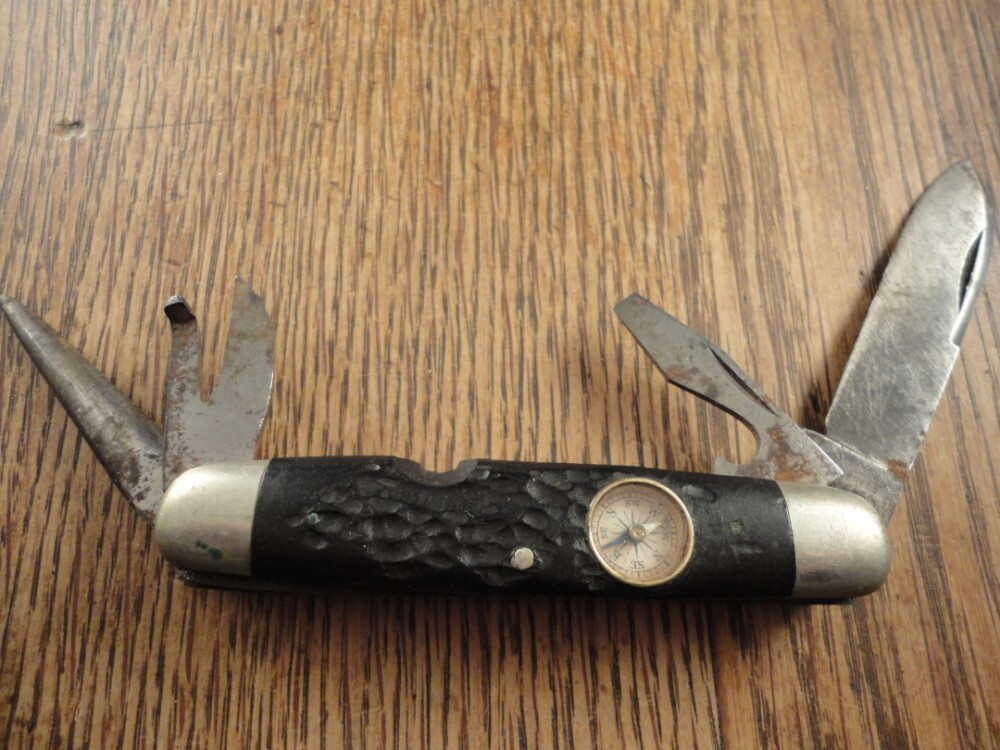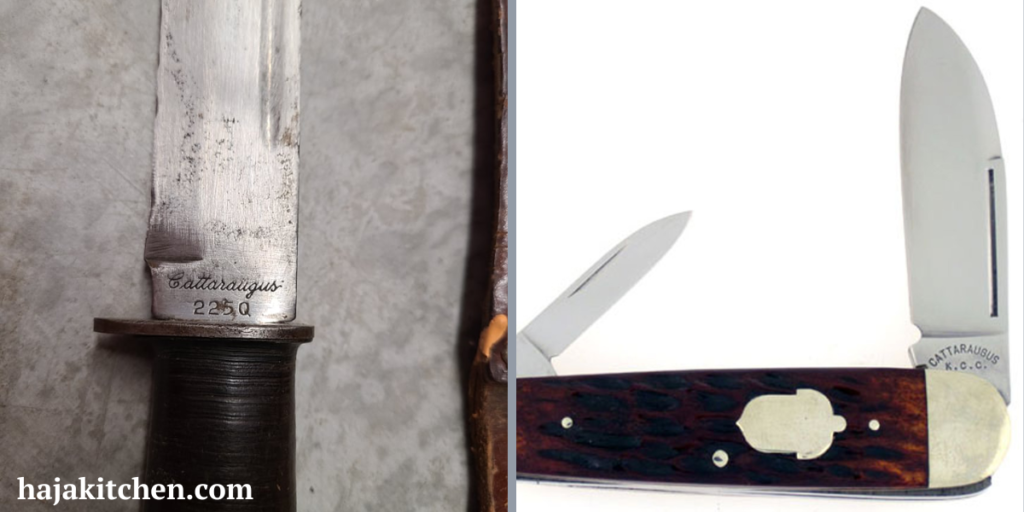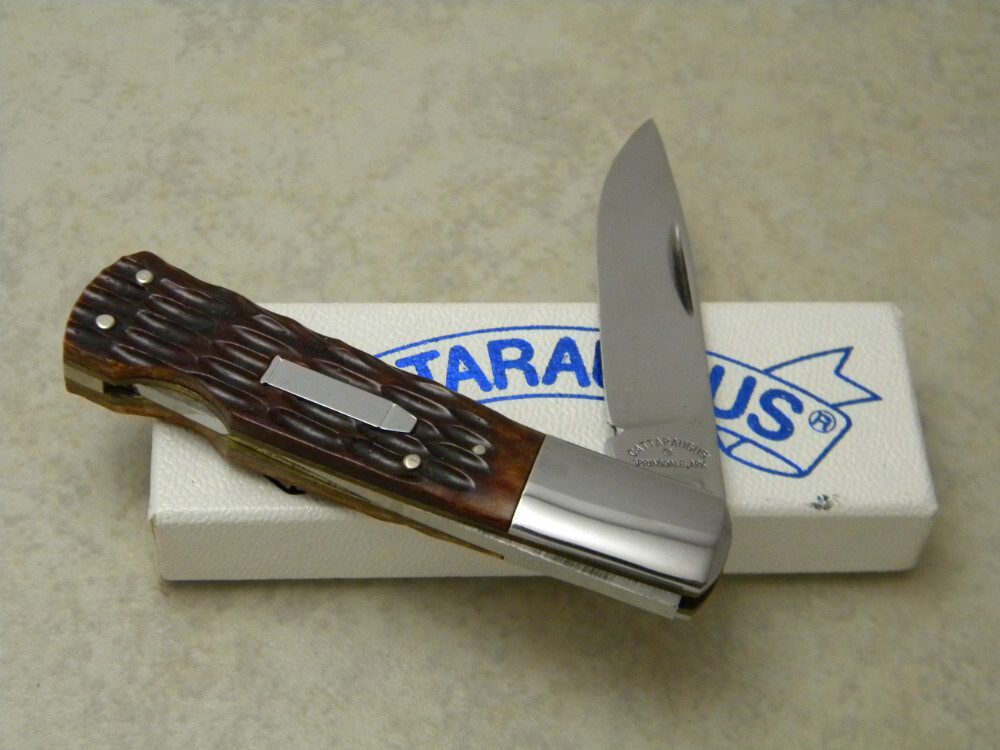If you are a knife collector, you are well aware that few brands hold the prestige and allure of Cattaraugus knives. These remarkable cutlery pieces have garnered a dedicated following among both novice enthusiasts and expert collectors.
If you’ve found yourself in possession of such treasure, you may be intrigued by its rich history and craftsmanship, wondering just how to determine its age and origin.
Fear not, for in this comprehensive guide, we will teach you how to date a Cattaraugus knife.
We will explore the intricacies of Cattaraugus knives, the legacy of the Cattaraugus Cutlery Company, and the techniques employed by expert knife collectors to pinpoint the age and historical significance of these prized possessions.
So, if you’ve ever wondered about the exact year your Cattaraugus knife was crafted or want to learn more about the fascinating history behind this iconic brand, join us on this journey through time and craftsmanship and learn how to date a Cattaraugus knife.
The main challenges of dating Cattaraugus knives

While dating the knives can be a rewarding pursuit, it comes with its fair share of challenges.
Let’s delve into the primary challenges faced by any knife collector when attempting to date a Cattaraugus knife:
One of the most significant challenges in dating Cattaraugus knives lies in the diversity of tang stamps used by Cattaraugus Cutlery throughout its history. These stamps, which are imprinted on the knife tang (the part of the knife hidden within the handle), often changed over the years. Deciphering these tang stamps and correlating them with specific production periods can be a formidable task.
Cattaraugus knives are celebrated for their extensive array of blade patterns. Over time, the company introduced so many patterns, each with its unique characteristics. Identifying the specific pattern of a Cattaraugus knife is essential for identifying the exact year of its production, but this can be challenging due to the sheer number of patterns produced.
For example, two knives could have the same factory number and alternate designs.
The handle material used in Cattaraugus knives also evolved over the years. Collectors must consider the types of materials of the handles employed during different production periods to estimate a knife’s age accurately. Varieties range from classic bone and wood to more exotic materials like Oriental pearl.
Unlike some other knife manufacturers, Cattaraugus Cutlery did not maintain comprehensive records of production and date codes. This absence of detailed historical documentation can make it challenging to establish precise timelines for specific knife models.
Each Cattaraugus knife model was assigned a unique pattern number. These numbers can offer valuable clues about a knife’s age, but they must be cross-referenced with other factors, such as tang stamps and materials of the handles, to provide a more accurate date.
The Second World War brought about changes in manufacturing processes and materials availability, which influenced the design and production of Cattaraugus knives. Understanding these post-war modifications is crucial for dating knives produced during this era.
In the face of these challenges, successful Cattaraugus knife dating often requires a combination of expertise, careful examination, and access to reference materials and resources.
How to date a Cattaraugus knife: most efficient techniques

Successfully dating a Cattaraugus knife requires a blend of patience, knowledge, and meticulous observation. While the process can be challenging, several methods and strategies have proven effective in determining the age and historical context of these exceptional blades.
#1. Tang stamp analysis
Tang stamps, the markings on the blade tang, serve as crucial clues in dating the knives. Collectors often rely on comprehensive guides and reference materials that catalog the various stamps used by Cattaraugus Cutlery over the years. By comparing the tang stamp on a knife to these references, collectors can estimate the approximate production date.
#2. Handle material identification
Different eras saw the use of specific materials used for the handles in Cattaraugus blades. For example, early knives often featured handles made of bone or wood, while post-WWII knives might have handles crafted from synthetic materials like celluloid. Familiarity with the evolution of these materials can aid in dating.
#3. Pattern number research
Cattaraugus blades were assigned unique numbers for each model. Knife collectors can consult charts and databases to match a knife’s number to a production period. This method becomes particularly valuable when combined with other dating techniques.
#4. Historical context
Understanding the historical context of the Cattaraugus Cutlery Company can provide valuable insights into dating knives. Consider factors like changes in manufacturing techniques, materials availability (especially during wartime), the company’s history, or the trends at certain periods (like a trend for a pen blade) to place a knife within a specific timeframe.
#5. Knife features
Examining the specific features of a Cattaraugus knife can yield clues about its age. Look for variations in design, shape, and markings. Some older knives may have unique features or blade etchings that are no longer used in modern production.
#6. Expert consultation
For particularly challenging cases, seeking guidance from expert knife collectors or historians can be invaluable. Experienced collectors may have encountered similar knives and can provide valuable insights into their age and rarity.
#7. Cross-referencing multiple factors
The most effective dating methods often involve cross-referencing multiple factors, such as tang stamps, pattern numbers, materials, and blade styles. By triangulating information from various sources, collectors can arrive at a more accurate estimate of a knife’s age.
#8. Catalogs and price guides
Knife catalogs and price guides, especially those specific to Cattaraugus blades, can be valuable references. These resources often contain historical information, illustrations, and estimated production years for different knife models.
A little bit of history of Cattaraugus knives

To truly appreciate the art of dating Cattaraugus knives, one must delve into the captivating history of the Cattaraugus Company itself.
The Early Years. The story of a Cattaraugus knife begins in Little Valley, New York, where the Cattaraugus Cutlery was established in 1882. The company quickly gained a reputation for producing high-quality pocket knives and other cutting tools.
During this era, many of their knives featured handles made from materials like bone and wood, reflecting the craftsmanship of the time and the sophistication of knife-making equipment.
World War influence. The outbreak of WWI in 1914 had a significant impact on Cattaraugus knives. Like many cutlery manufacturers of the time, the company shifted its focus to producing military knives for the armed forces. These wartime knives were often marked with specific military designations and played a crucial role in the war effort.
The Golden Age. The period between the two World Wars is often considered the “Golden Age” of Cattaraugus knife making. The company expanded its offerings, introducing a wide variety of blade patterns and handle materials, including striking red celluloid and others. This era saw the production of some of the most sought-after Cattaraugus blades by collectors today.
World War II and beyond. WWII again prompted changes in the cutlery industry, with manufacturers adapting to wartime production demands. Cattaraugus knife making from this era may exhibit variations in materials and design as the company adapted to the constraints of the war economy.
Post-war challenges. After WWII, the Cattaraugus Cutlery faced challenges in a changing market. Like many traditional knife manufacturers, they made knives that struggled to compete with modern folding knife designs and materials. Ultimately, the company ceased production in the early 1960s, marking the end of an era for Cattaraugus knives.
Legacy and collectibility. Despite the company’s closure, the legacy of the knives endures. Their commitment to exceptional quality, craftsmanship, and attention to detail has made knives of that brand highly collectible. Today, many collectors treasure Cattaraugus knives not only for their functionality but also as pieces of American cutlery history.
Tang Stamps on Cattaraugus Knives: deciphering the Code

These stamps are a crucial element in the world of knife collecting, serving as small but significant markings on the tang, or the portion of the blade that resides within the knife’s handle. Understanding the meaning of the stamps is essential for dating and identifying these prized knives.
Manufacturer’s mark: at its core, a tang stamp on a Cattaraugus knife typically bears the manufacturer’s mark or logo. This mark identifies the knife as a product of the Cattaraugus Cutlery. Over the years, the company used different variations of its logo, allowing collectors to place knives within specific timeframes.
Production era: the stamps are a direct reflection of the period during which a knife was manufactured. The manufacturer utilized various stamp designs and changes in their logos throughout their history. By studying these changes, collectors can estimate when a knife was produced.
Model identification: in addition to the manufacturer’s mark, the stamps on the knives often include other information, such as a model factory number or a name. This provides collectors with valuable details about the specific knife model they are examining.
Special designations: in some cases, the stamps may feature special designations that indicate the intended use of the knife or market. For example, knives produced for military contracts during wartime may bear markings denoting their military origin.
Rarity and collectibility: Certain stamps, especially those associated with limited-edition or rare knife models, can significantly impact a knife’s collectibility and value. Stamps that indicate a knife’s uniqueness or historical significance are highly sought after by collectors.
Reference Materials: to decipher the meaning of the stamps effectively, collectors often rely on reference materials and guides specific to Cattaraugus knives. These resources catalog the various stamp designs used by the company over the years, making it easier to identify and date knives accurately.
The stamps on Cattaraugus knives are more than just markings; they are a gateway to understanding the knife’s history, age, and significance.
Final thoughts
In the world of knife collecting, Cattaraugus knives stand as remarkable treasures, each a testament to a bygone era of craftsmanship, innovation, and American cutlery heritage.
Throughout this guide, we’ve explored the intricacies of dating Cattaraugus knives, from deciphering tang stamps and handle materials to understanding the rich history that shaped these knives. We’ve unveiled the challenges faced by collectors and the methods they employ to overcome them, from cross-referencing multiple factors to seeking expert guidance.
Cattaraugus knives are more than mere tools; they are artifacts that connect us to our history and heritage.
FAQ
What is the history of Cattaraugus knives?
Cattaraugus knives have a rich history, with the Cattaraugus Cutlery Company being founded in 1882 in Little Valley, New York. They started with a jobbing operation and ended up producing high-quality pocket knives, served during both World Wars, and closed in the early 1960s, leaving a lasting legacy in the world of cutlery.
Are Cattaraugus knives any good?
Yes, Cattaraugus knives are highly regarded for their exceptional quality, craftsmanship, and collectibility. This knife is considered to be of good quality and is valued by knife collectors.
Where are Cattaraugus knives made?
Cattaraugus knives were made in New York, where the Cattaraugus Cutlery Company was founded and operated.
What is the history of a Kinfolks knife?
The company was founded in 1924 basically as a family business in NY. It was established to overcome the deficit of fixed-blade knives of the other businesses of the family: Case & Sons and Cattaraugus.


